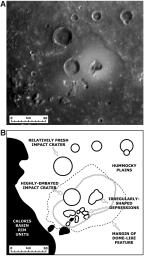Mapping a Volcano
Caption:
MESSENGER Science Team members are busy studying in detail the newly discovered volcanoes on Mercury (see
PIA10942
). This figure, recently published in
Science
magazine, shows a NAC mosaic of the largest volcano currently identified on Mercury and a geologic sketch map of the major features in the surrounding area. The "irregularly-shaped depressions" are believed to correspond to volcanic vents, and the "margin of the dome-like feature" marks the outer limits of lava flows from the vents that are thought to have covered up the underlying surface of "hummocky plains." The unlabeled double line outlines bright material associated with the volcano, believed to be pyroclastic deposits ejected during volcanic eruptions at the vents. A "highly-embayed impact crater" also appears to have had lava flow up to its rim, while a slightly more distant impact crater is "relatively fresh" and unchanged by any lava. The volcano is located just inside the rim of the Caloris impact basin (see
PIA10383
), labeled as "Caloris basin rim units" on this map. Maps such as this are aiding scientists as they work to understand the history of volcanism on Mercury.
Date Acquired:
January 14, 2008
Image Mission Elapsed Time (MET):
Mosaic of 108826812 and 108826877
Instrument:
A: Narrow Angle Camera (NAC) of the Mercury Dual Imaging System (MDIS)
Spacecraft Altitude:
10,500 kilometers (6,500 miles)
Background Info:
These images are from MESSENGER, a NASA Discovery mission to conduct the first orbital study of the innermost planet, Mercury. For information regarding the use of images, see the MESSENGER
image use policy
.
Cataloging Keywords:
| Name |
Value |
Additional Values |
| Target |
Mercury |
|
| System |
|
|
| Target Type |
Planet |
|
| Mission |
MESSENGER |
|
| Instrument Host |
MESSENGER |
|
| Host Type |
Orbiter |
|
| Instrument |
Mercury Dual Imaging System (MDIS) |
|
| Detector |
Narrow Angle Camera (NAC) |
|
| Extra Keywords |
Crater, Grayscale, Impact, Map, Volcano |
| Acquisition Date |
|
| Release Date |
2008-08-19 |
| Date in Caption |
2008-01-14 |
|
| Image Credit |
NASA/Johns Hopkins University Applied Physics Laboratory/Arizona State University/Carnegie Institution of Washington. Figure 1 from Head et al., Science, 321, 69-72, 2008. |
| Source |
photojournal.jpl.nasa.gov/catalog/PIA11013 |
| Identifier |
PIA11013 |

 Planetary Data System
Planetary Data System
